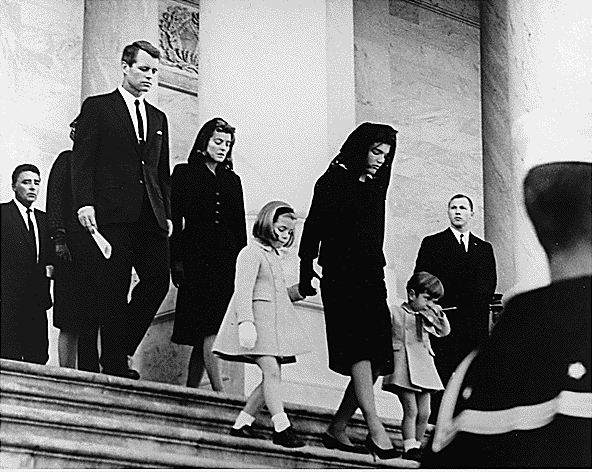
Figure 1 – Photo of Jacqueline Kennedy, Robert Kennedy, John Jr, Caroline and Peter Lawford at the funeral of John Fitzgerald Kennedy, 25 November 1963, walking down steps of the United States Capitol. From the National Archives via the Wikimedia Commons and in the public domain.
As most people know, today marks the fiftieth anniversary of the assassination of John F. Kennedy. My original thought was just to post the image of Figure 1, and let it speak for itself. But really there is a lot more to be said in terms of what the myriad of iconic images from that day have to say.
First, consider Friday, January 20, 1961. It was a snow day in New York City and as a result I got to stay home to watch the inauguration on the television. It was the first inauguration that I watched, really the birth of my political awareness. What is significant was the view that Americans had, at that moment, that whatever we set our collective minds and spirits to we could accomplish. Those were heady times coming out of World War II, the center of what has been called the American Century – and, of course, it represents a classic example of what others have derogatorily called “American Exceptionalism.” I think that rather than deriding American exceptionalism we should look towards a more universal human exceptionalism. The important point is that these were enormously optimistic times in the United States, and, of course too, we were about to pay again for racial intolerance.
This optimism ended on Friday, November 22, 1963. Really! It just died with the presidnet. When the word came out of the loud speaker at my Junior High School – the principal simply turned on the news – the feeling of despair and lost innocence was honestly palpable. I remember one little girl shouting out: “He deserved it!” And I remember thinking that she really didn’t mean it. Now five decades later I take that utterance as an awful harbinger of the depths to which our political discourse would plummet. The level of disrespect for our current president by his domestic opponents – well, and I hate to say it – is thinly disguised racism. It is not worthy of a free people.
So then the weekend progressed. From one in the afternoon Eastern time on Friday when the news first broke, the networks broadcast endlessly until Tuesday night. And television was a three network show in those days – thre channels of drivel instead of two hundred. For four days there was live-from-the-scene reporting. For the first time, there was extensive mobile on-the-spot video. Ever seen what a 1960’s vintage television camera looked like – this was a tour de force technically.
It is hard to remember what television was before the Kennedy assassination. This is because that moment changed it. We demanded ever detailed on-the-spot reporting. We wanted cameras on the battle field, covering an endless series of genocides, and even on the moon for that first footstep.
Throughout the sixties and seventies that phrase “We interrupt this program with an important news bulletin,” made your heart stop a beat and you held your breath. Robert Kennedy’s assassination, Martin Luther King’s Assassination, Nine-eleven: everything became so real and visceral.
And as we have discussed we have become enured – really hardened. And at the same time the news media and now social media have trivialized the phrase “breaking news.” Beyonce’s baby bump (and I wish her only good thing) does not, in any context of the phrase, truly constitute “breaking news.”
Our world and what we expect from our media was changed that Friday in November. The endless personal and raw imagery that we demand and then devoured evolved from what we saw on our little grainy black and white televisions that weekend.

My memories, and the take on them, corroborate and concur. Thanks for taking the time to tease them out of your own strands.
Yes, Marilyn. I have been taken aback by a lot of the retrospectives being broadcast, like the one I saw about the 1960 Wisconsin Primary last night. Back then, we looked forward and were optimistic about the future. Now we know that future and are both pleased and disappointed. The past is not “the good ol’ days.” The present fails to shows us enough improvement. And as for the future, we are leery of being seduced again! I still believe in Kennedy’s America. I believe not “because it is easy, but because it is hard.” Maybe I can find a picture of the Berkeley riots, which shows MF among the tear gas. 8<}